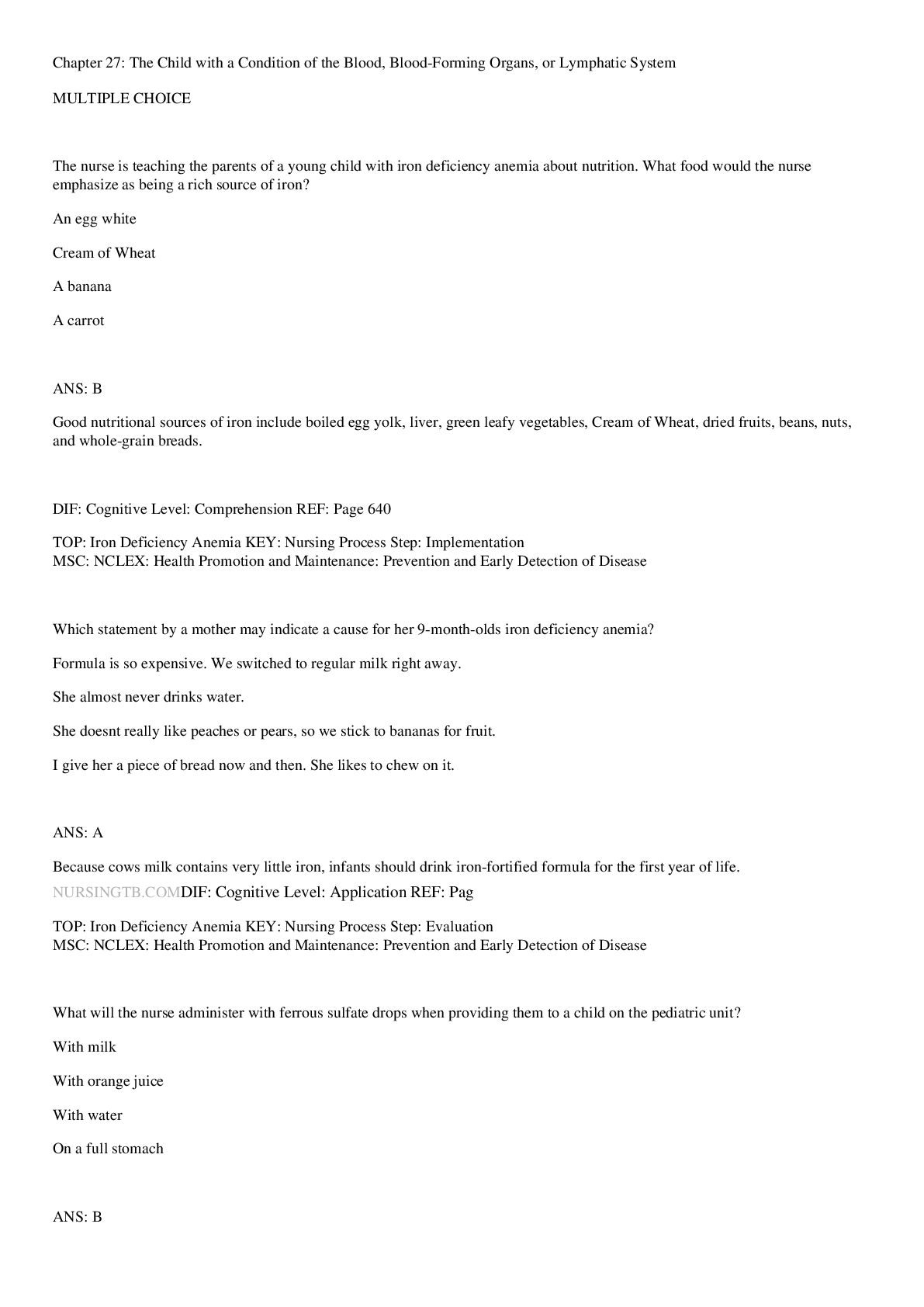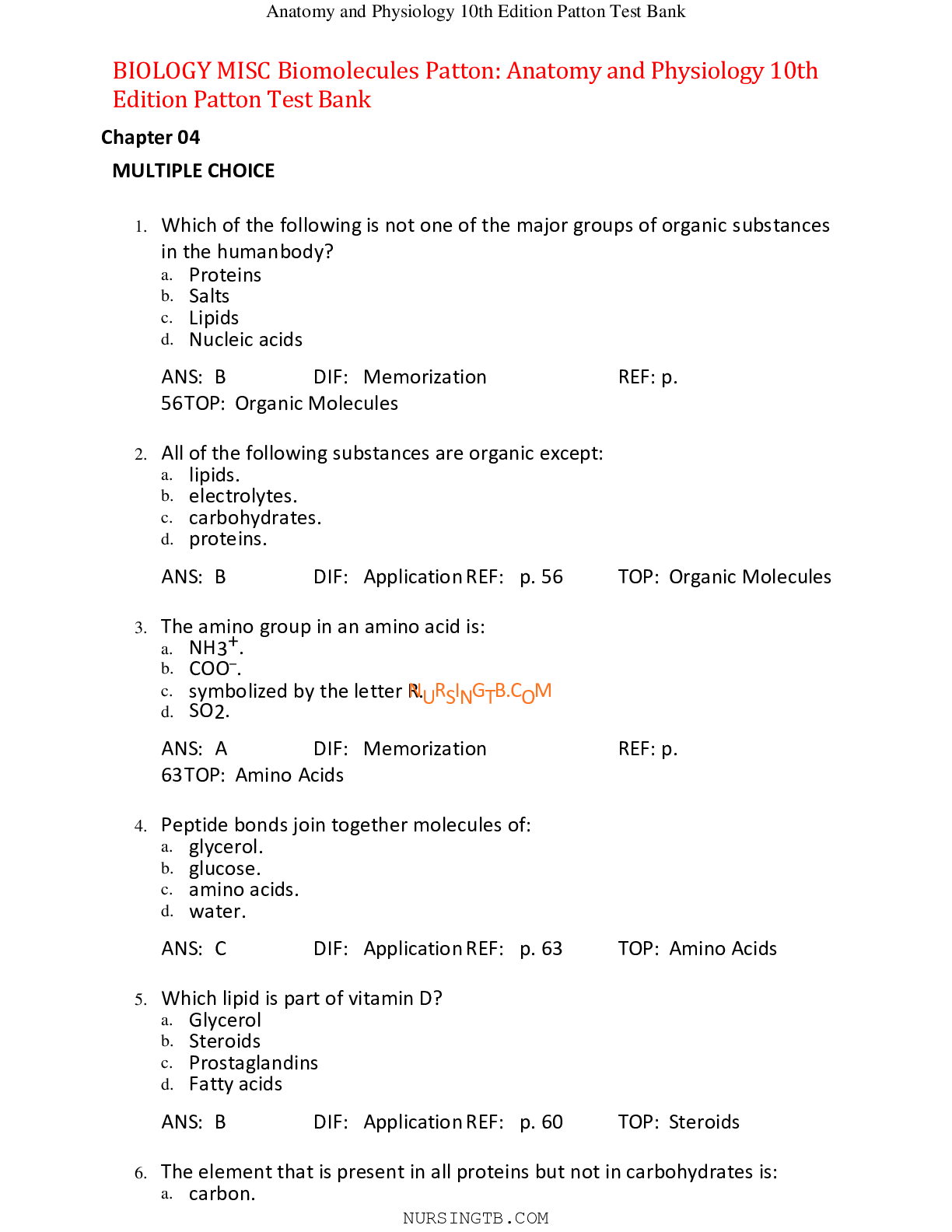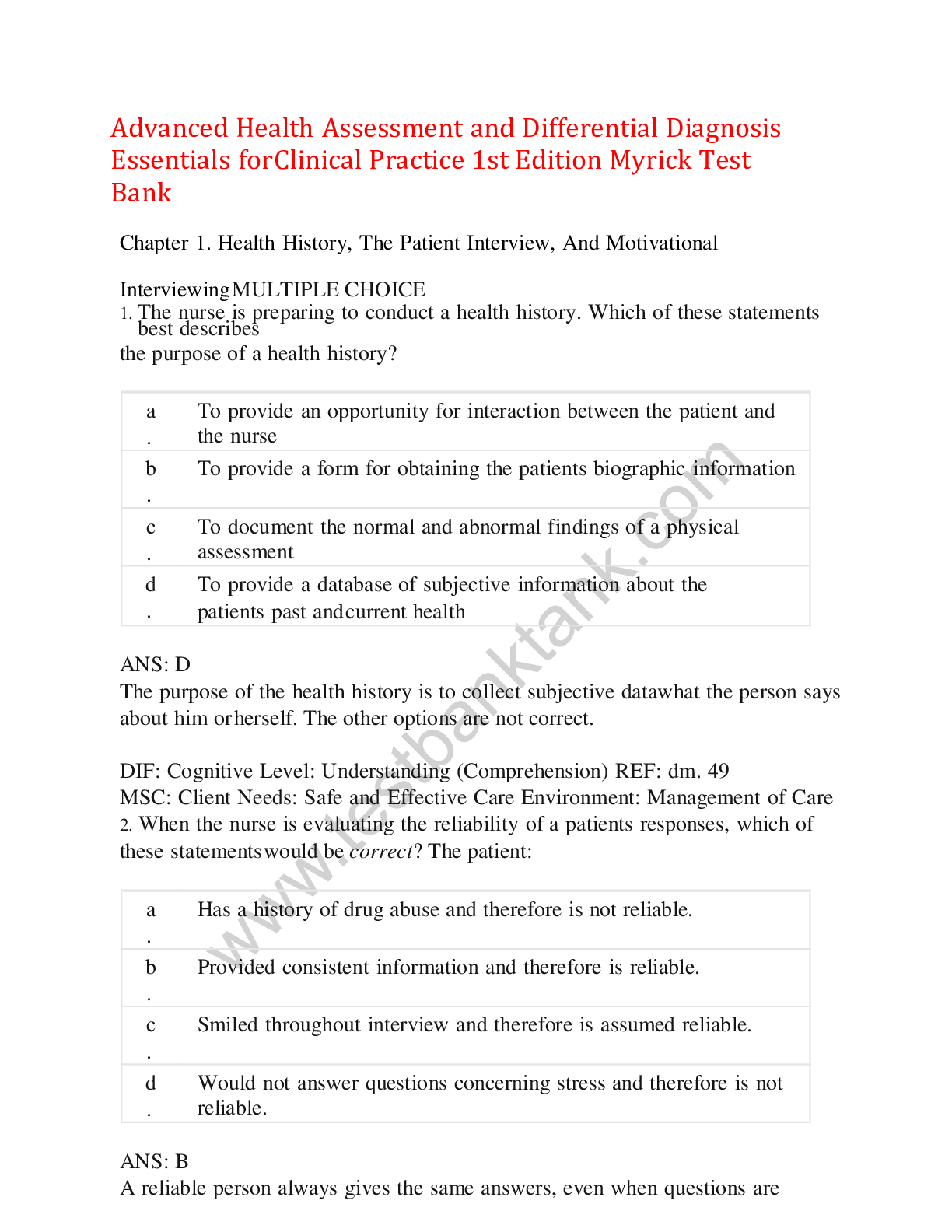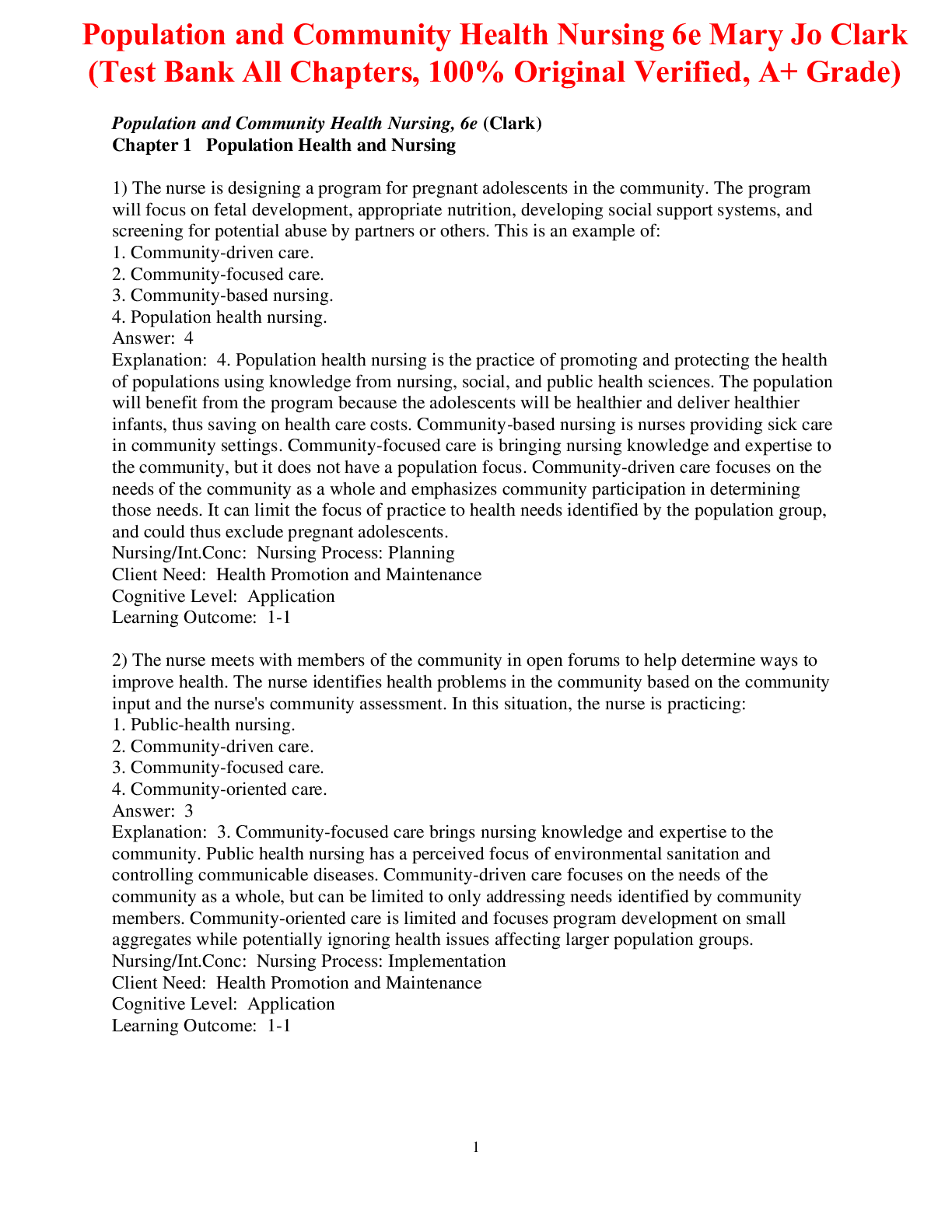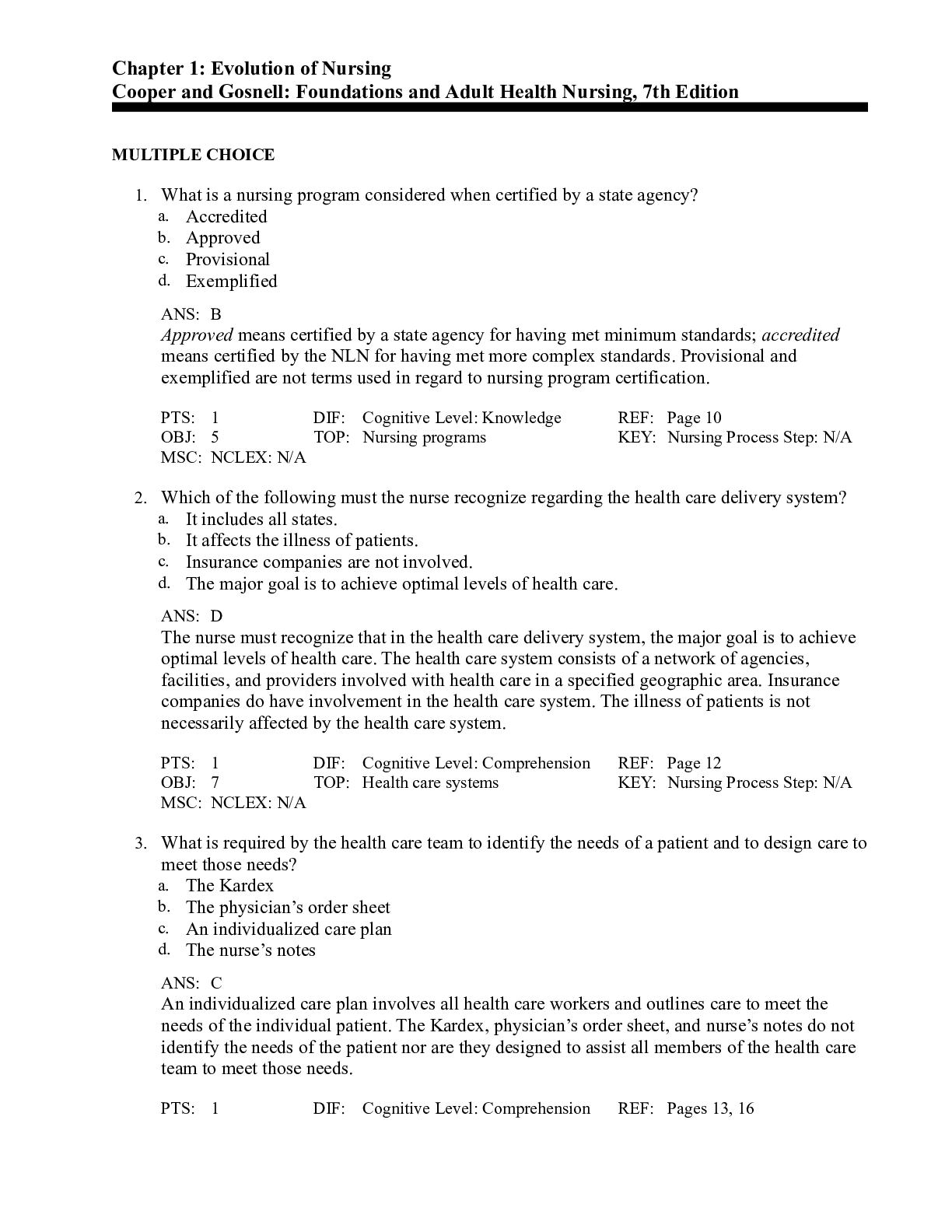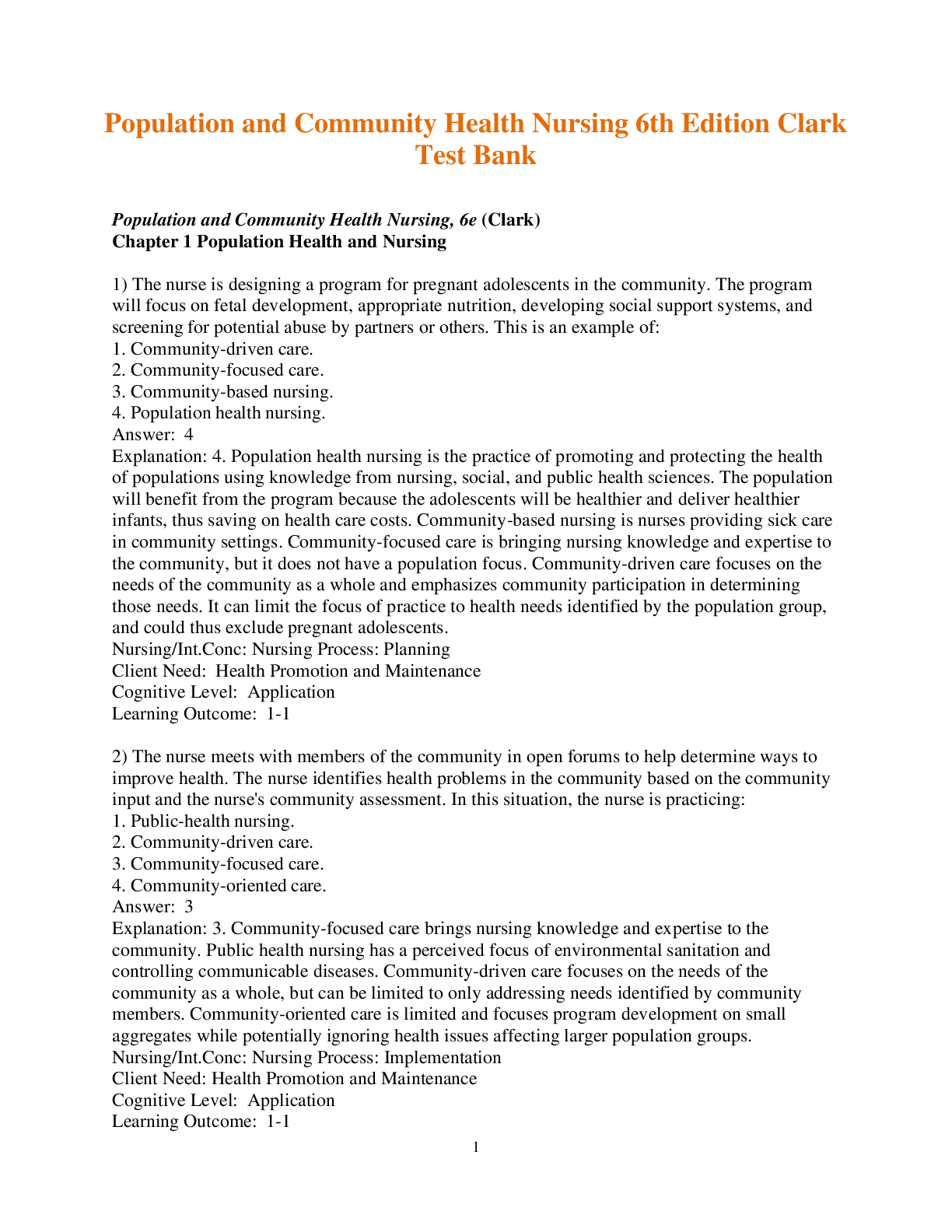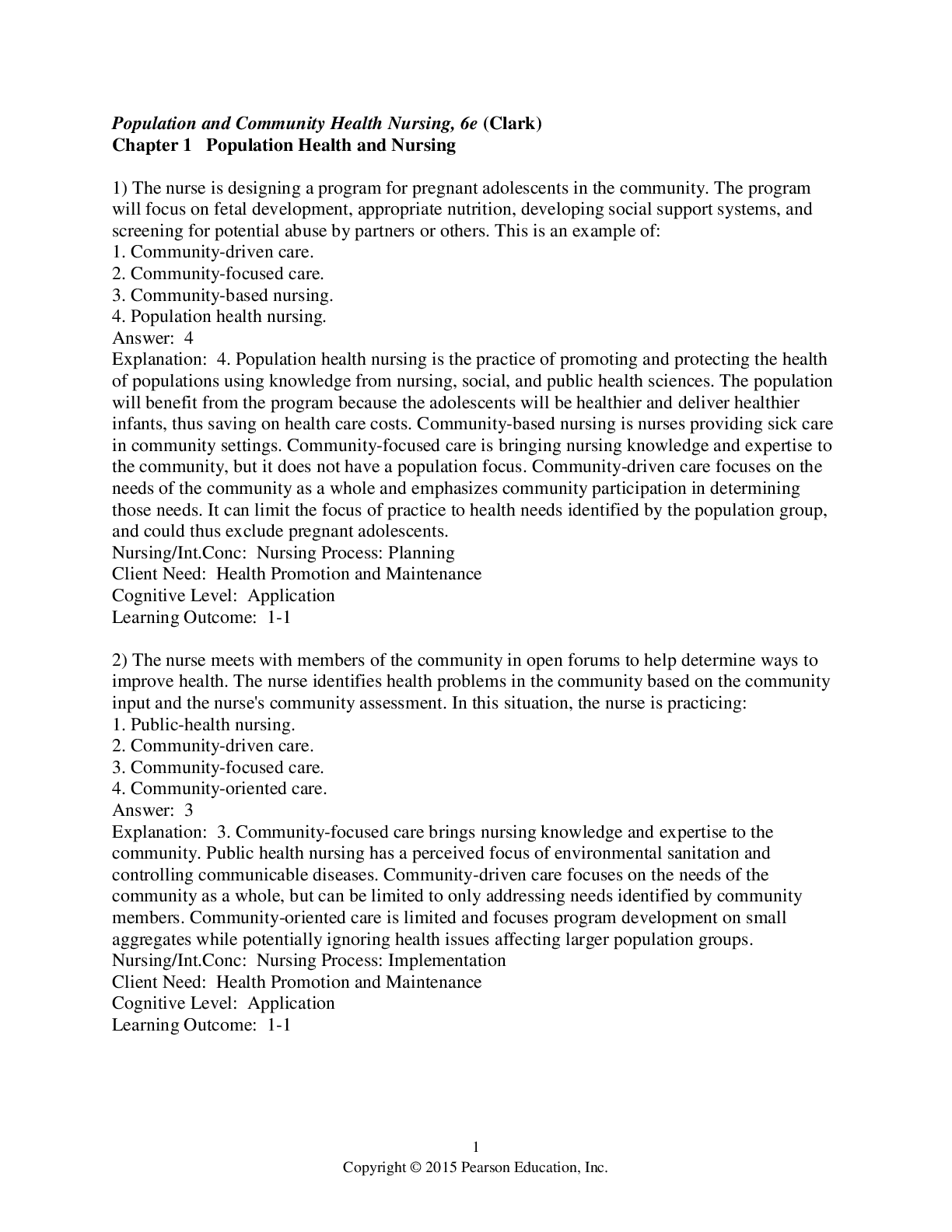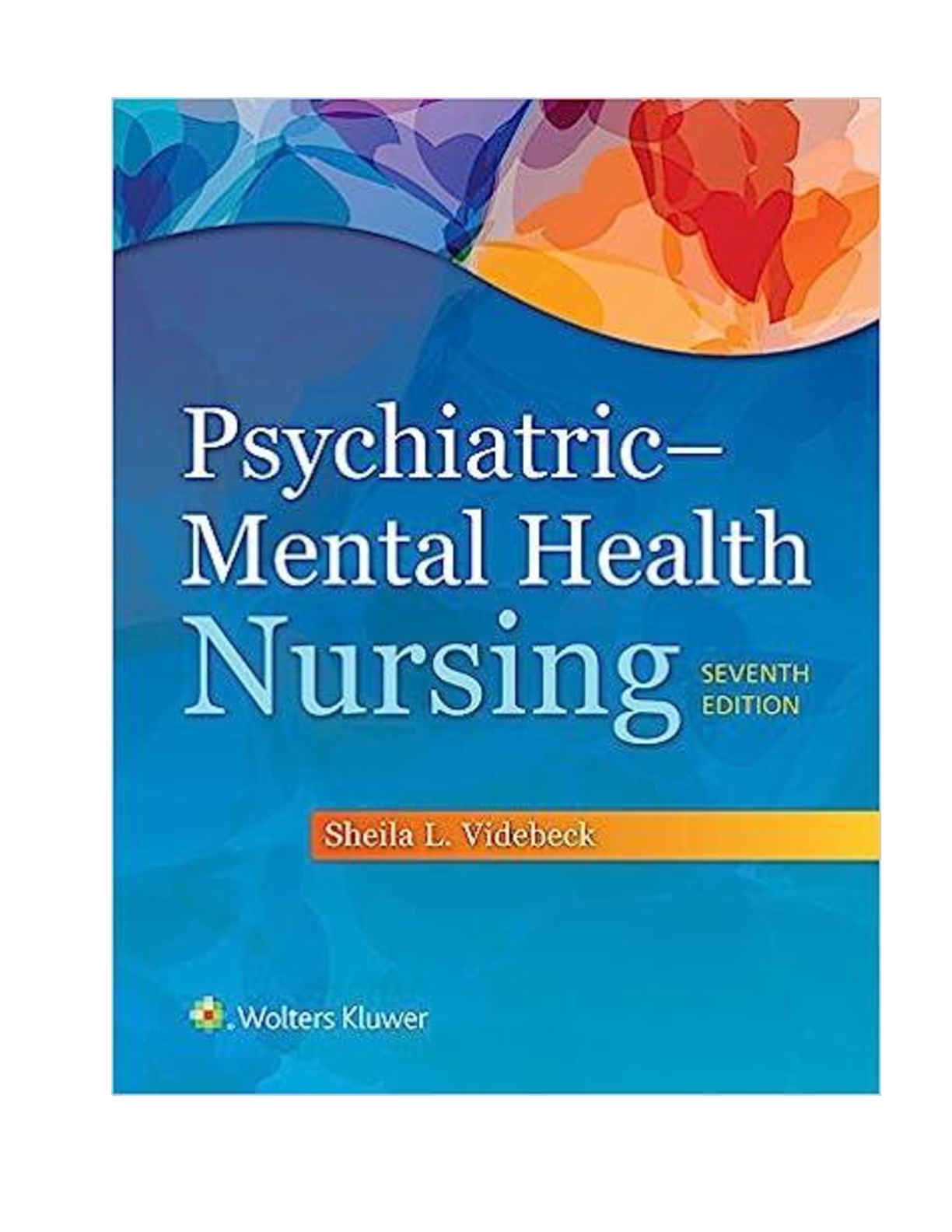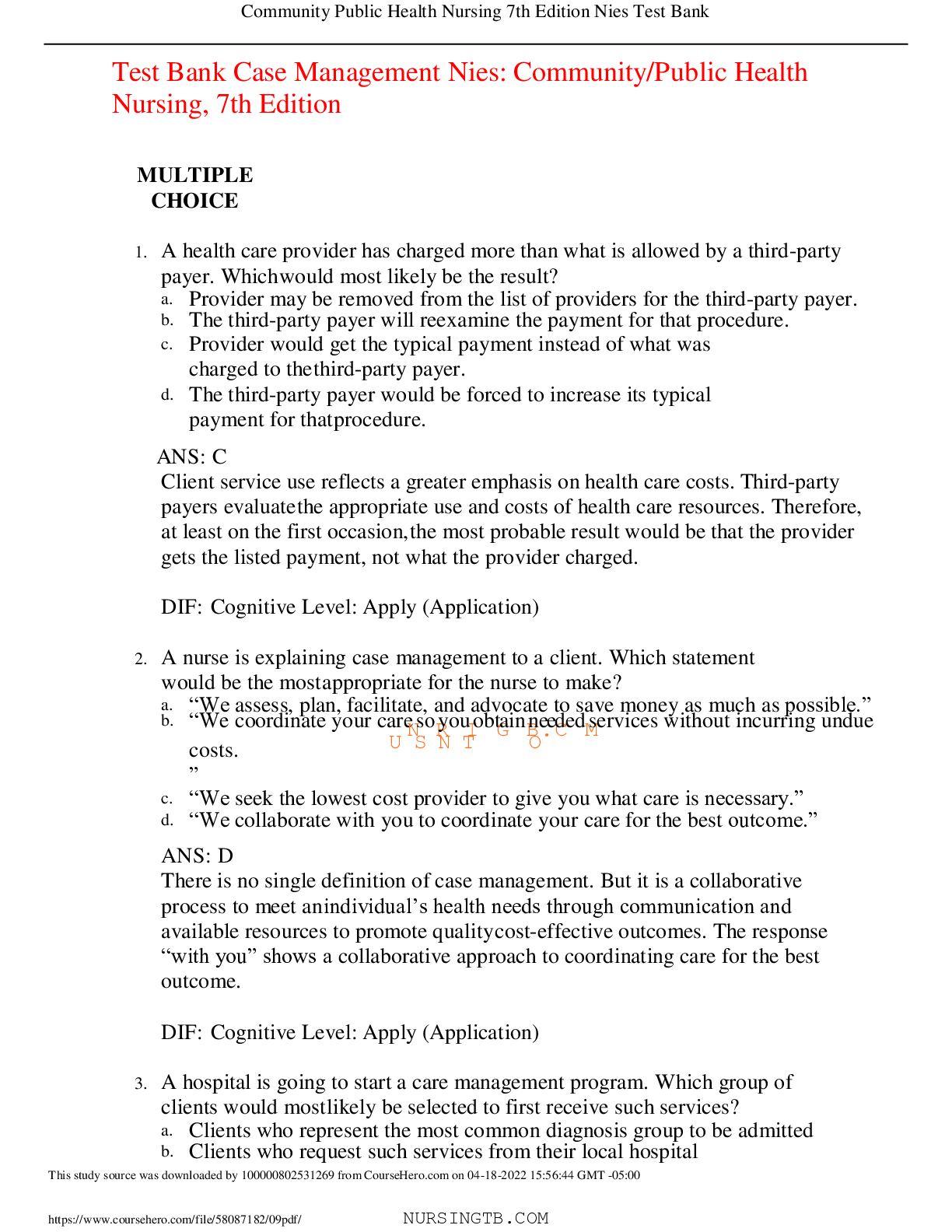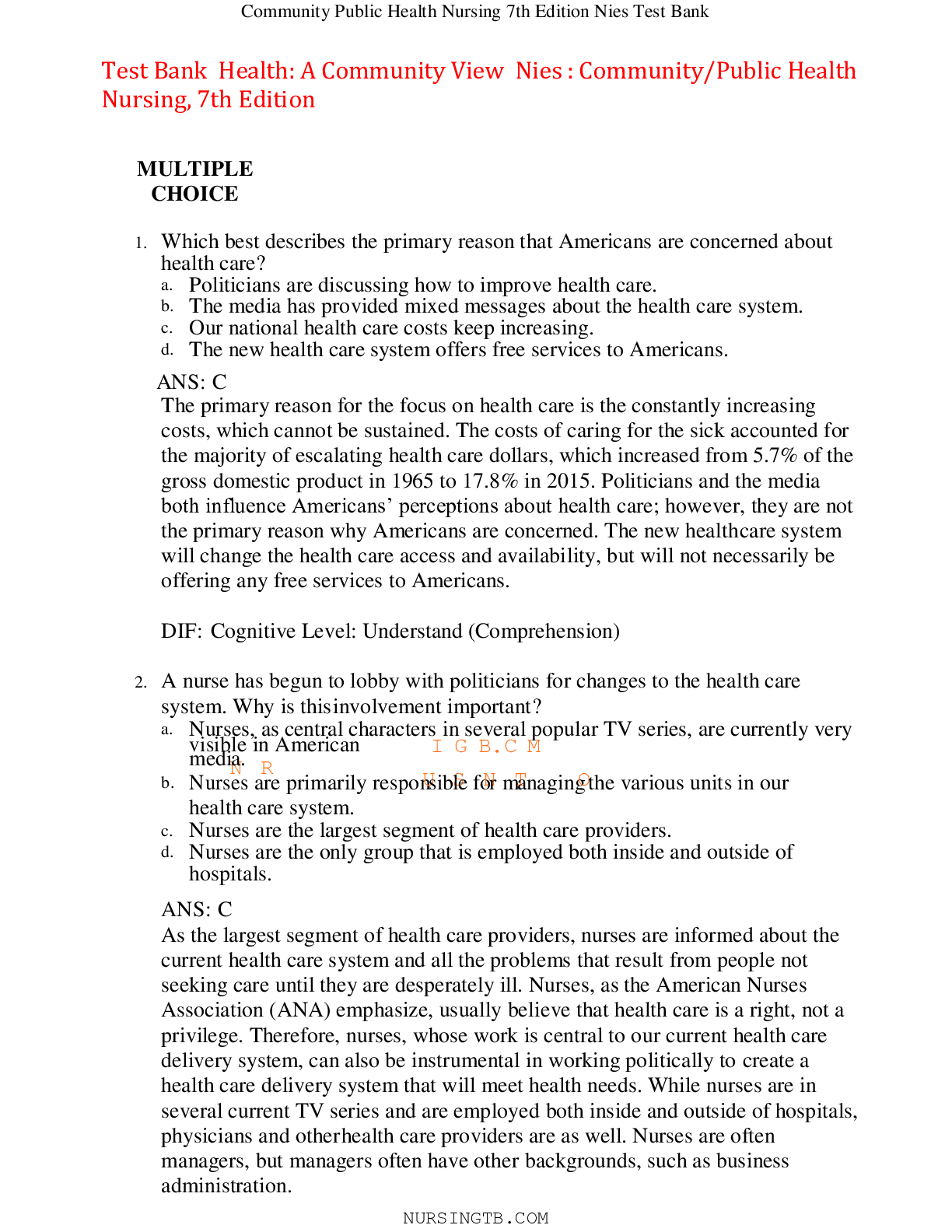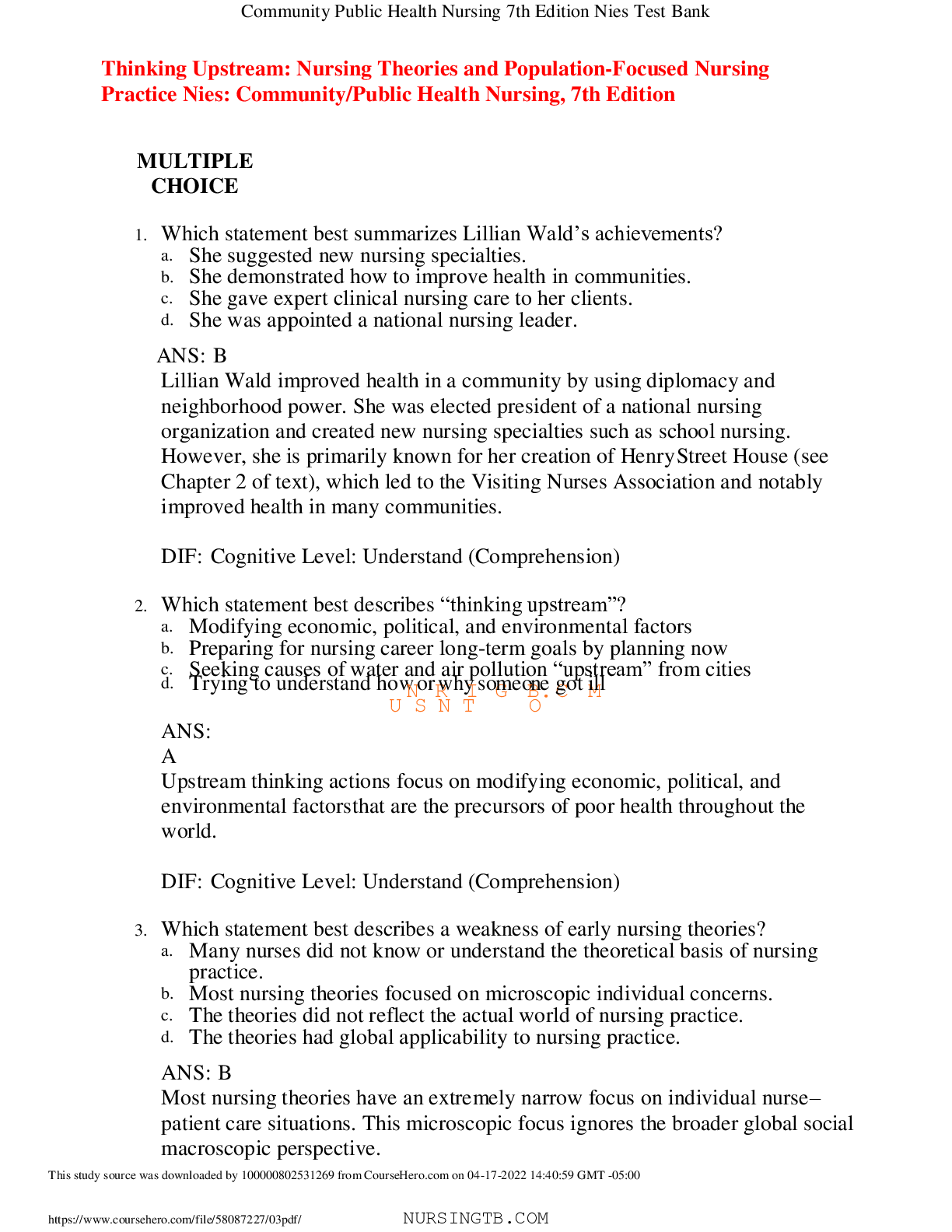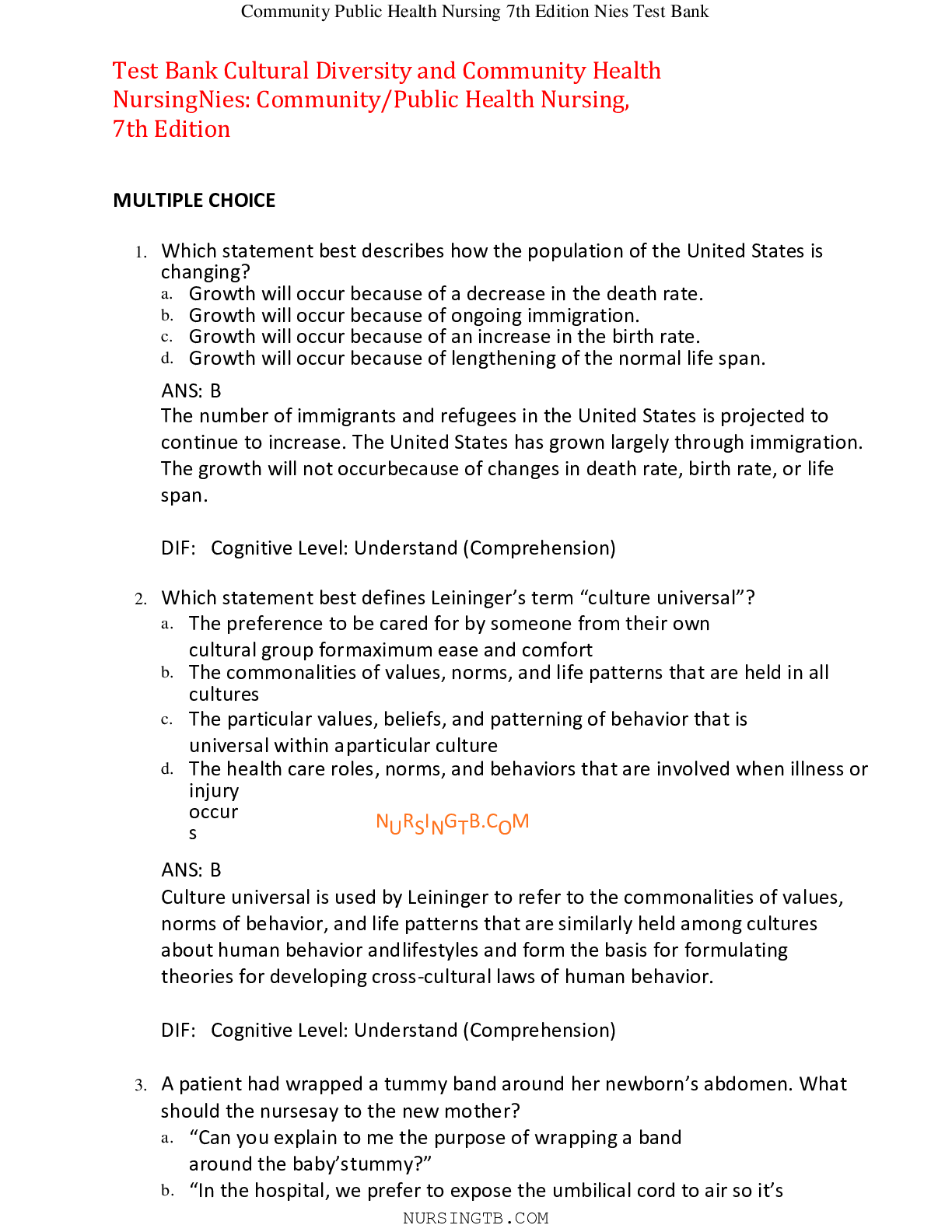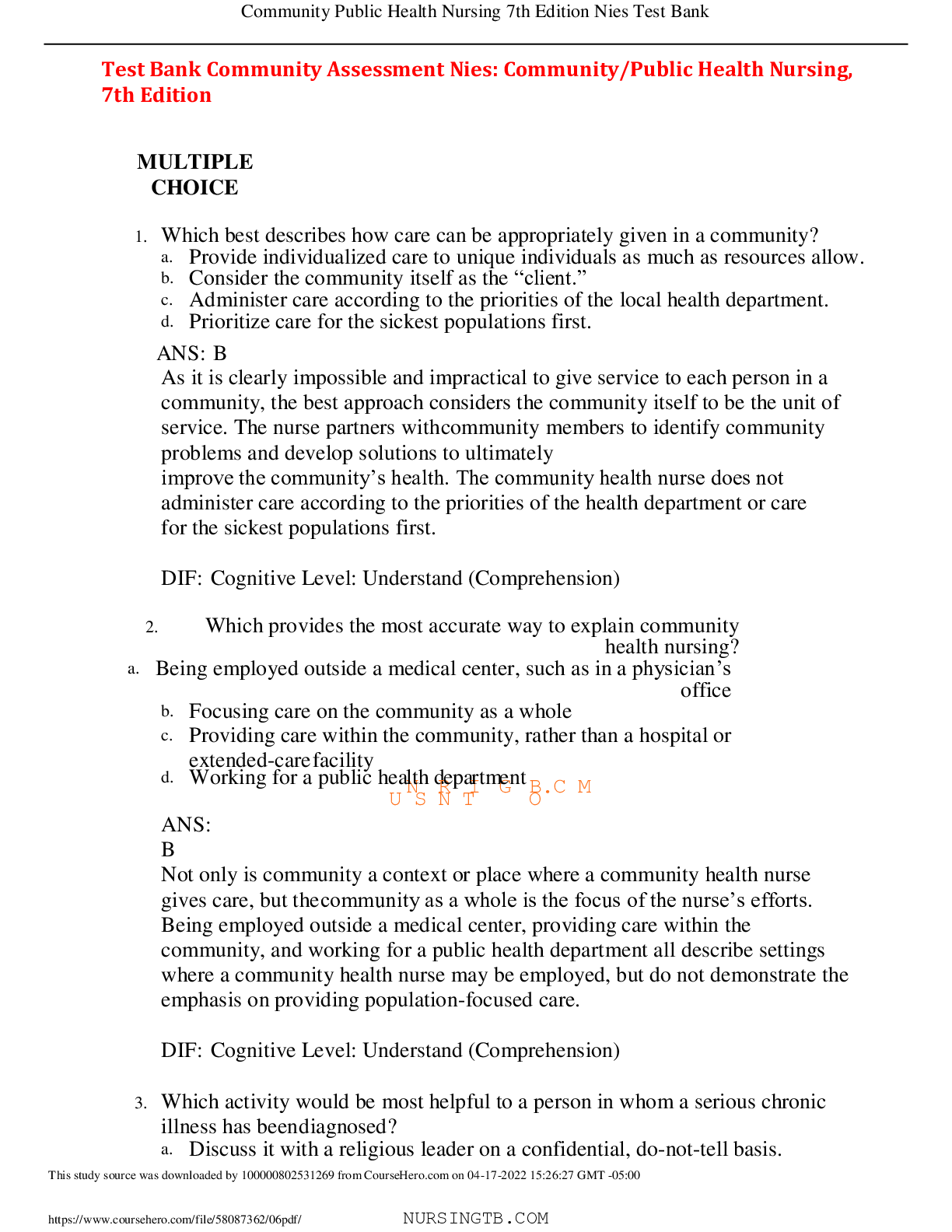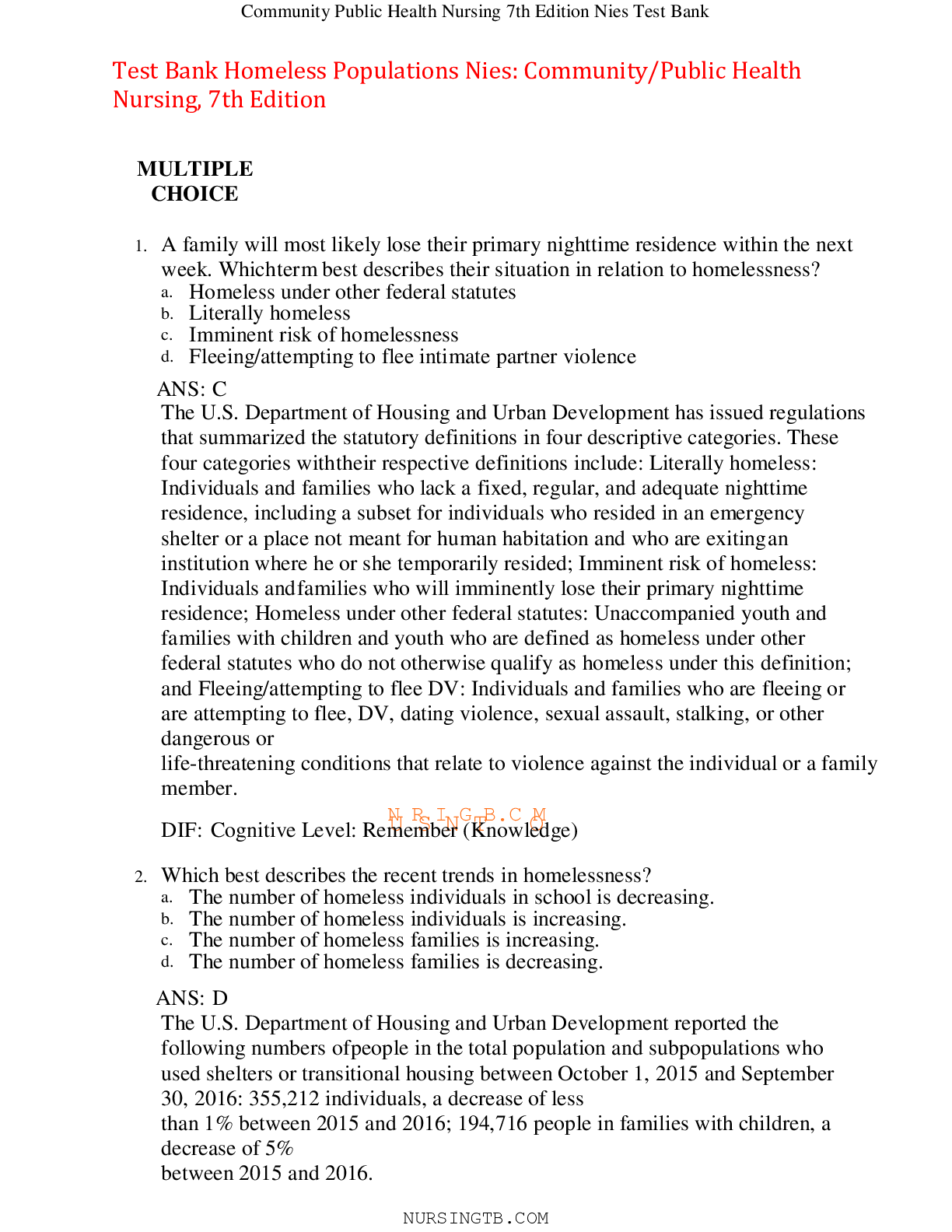*NURSING > TEST BANK > Test Bank Policy, Politics, Legislation, and Community Health Nursing Nies: Community/Public Health (All)
Test Bank Policy, Politics, Legislation, and Community Health Nursing Nies: Community/Public Health Nursing, 7th Edition,100% CORRECT
Document Content and Description Below
Test Bank Policy, Politics, Legislation, and Community Health Nursing Nies: Community/Public Health Nursing, 7th Edition MULTIPLE CHOICE 1. Which nurse fought to have American nursing controll... ed by nurses rather than physicians? a. Clara Barton b. Florence Nightingale c. Lavinia Dock d. Lillian Wald ANS: C Lavinia Dock was a political activist who waged a campaign for legislation to allow nurses to control the nursing profession. Florence Nightingale was the first nurse to exert political pressure on a government. Clara Barton was responsible for organizing relief efforts during the U.S. Civil War. Lillian Wald was the driving force behind the federal government’s development of the Children’s Bureau in 1912. DIF: Cognitive Level: Remember (Knowledge) 2. Which nurse used political expertise to influence the federal government to develop a Children’s Bureau? a. Clara Barton b. Florence Nightingale c. Lavinia Dock d. Lillian Wald ANS: D NURSINGTB.COM Lillian Wald recognized the connection between social conditions and health. She was a driving force behind the federal government’s development of the Children’s Bureau in 1912. Lavinia Dock was a political activist who waged a campaign for legislation to allow nurses to control the nursing profession. Florence Nightingale was the first nurse to exert political pressure on a government. Clara Barton was responsible for organizing relief efforts during the U.S. Civil War. DIF: Cognitive Level: Remember (Knowledge) 3. Which best describes the most important factor in legislation? a. The amount of financing and lobbying behind each choice b. The beliefs, attitudes, and values of the policy c. The preferences of the majority of American voters d. The president’s ongoing encouragement for one particular choice ANS: B Public policy encompasses the choices made regarding goals, priorities, and how resources are allocated. Policy choices reflect the values, beliefs, and attitudes of those designing the policy. The influence of the president, preferences of Americans, and amount of financing related to the legislation are not as important as the beliefs, attitudes, and values of the policy. DIF: Cognitive Level: Understand (Comprehension) 4. Which is accomplished through the use of public policy? a. Solutions to problems of public concern are developed. b. A rational, logical problem-solving decision-making process is implemented. c. Public safety nets for vulnerable populations are created. d. Economic and business management principles are applied. ANS: A The field of public policy involves the study of specific policy problems and governmental responses to them. Political scientists involved in the study of public policy attempt to devise solutions for problems of public concern. The use of public policy may not involve the implementation of a logical problem-solving, decision-making process. Public policy addresses more than safety nets for vulnerable populations. Additional principles besides economics and business management are applied through the use of public policy. DIF: Cognitive Level: Understand (Comprehension) 5. Which best describes why it is so difficult to change the paradigm of health care from disease orientation to promoting health orientation? a. The belief exists that those without insurance could obtain insurance if they worked hard enough. b. People find it difficult to agree on what the ideal paradigm should be. c. People realize the media have exaggerated the problems that result from lack of insurance. d. Serious reallocation of resources would have to occur. ANS: D A shift in the paradigm woulNd UneRceSsIsitNatGe Ta Bsu.bsCtaOnMtial reallocation of resources because the vast majority of health spending is currently directed to medical care and biomedical research and reflects a viewpoint of health care as a commodity. The allocation of resources has the most influence on creating a paradigm shift. Individual opinions and the use of media do not play as great of role as where resources are spent. DIF: Cognitive Level: Understand (Comprehension) 6. Which best describes how the government controls conditions that individuals cannot? a. Appeals to the common sense and good nature of the citizens b. Establishes social mores that enable groups to control individuals’ behaviors c. Passes and enforces law d. Uses fear reinforced by police power ANS: C Government regulates conditions that individuals cannot control and provides individual protection through a population-wide focus. These tasks are accomplished through passage and enforcement of laws. These laws control individuals’ behaviors, which may lead to the establishment of social mores and common sense related to the laws that have been established. DIF: Cognitive Level: Understand (Comprehension) 7. Which statement best describes why the federal government is unable to do whatever politicians currently in power want? a. The citizens would rise up in rebellion if actions were outrageous. b. The lack of funds to implement actions is seen as unreasonable by a majority of voters. c. Only the actions authorized by the Constitution are legitimate. d. The states would rebel and withdraw from the union. ANS: C The federal government is a government of limited powers, which means that, for a federal action to be legitimate, it must be authorized. Only those actions that are within the scope of the Constitution, the supreme law of the land, are authorized. Power of the states and citizens is limited under the overall umbrella of the federal government. Funding is also controlled through the powers of the federal government. DIF: Cognitive Level: Understand (Comprehension) 8. Which is the basis for any American citizen to feel comfortable expressing an opinion on a political issue? a. Amendments to the Constitution b. Articles of the Constitution of the United States c. Declaration of Independence d. Gettysburg Address ANS: A Amendments to the Constitution, later known as the Bill of Rights, were added after the original Articles of the Constitution were ratified. These amendments protect individuals’ rights and freedoms. The DecNlaUraRtiSonIoNfGInTdBep.eCndOenMce announced the freedom of America from the British Empire. The Gettysburg Address was a speech given by President Abraham Lincoln following the Civil War. DIF: Cognitive Level: Understand (Comprehension) 9. Which best describes who has the authority to act in every area except those specifically mentioned in the Constitution? a. Any individual citizen b. Federal government c. Local government d. State government ANS: D Any powers not delegated to the federal government are reserved for the states. Thus, individual citizens, the federal government, and local governments are excluded. DIF: Cognitive Level: Understand (Comprehension) 10. Which best describes how the local government is provided authority? a. Through the ability to tax local residents to meet local needs b. Through the people themselves who band together to create the community c. Power delegated from the federal level to the local level d. Power delegated from the states ANS: D States may delegate powers to the local government. Which powers they delegate vary widely from state to state. The federal government does not directly delegate power to the local level, and this occurs through state government. Taxation and creation of a community do not provide the local government with authority. DIF: Cognitive Level: Understand (Comprehension) 11. Which statement best describes how policies in the private sector are different from policies in the public sector? a. Private sector policies are slow, deliberate, and reactive to events. b. Private sector policies are determined by the opinions and feelings of those employed in that sector. c. Private sector policies are based on economics and market trends. d. Private sector policies are based on rational decision-making. ANS: C Private policy is largely influenced by theories of economics and business management, including consumerism and market trends. Such policies can react quickly and are often proactive. In comparison, public policies are slow and reactive, and economics is just one of many factors involved. Public policies are determined by voting shifts, electoral realignment, and term limits. DIF: Cognitive Level: Understand (Comprehension) 12. The president was sent a bill that he did not really like, but he would have been unpopular if he vetoed it, so he did nothing. Which best describes what will happen to the bill? a. The bill is dead. NURSINGTB.COM b. The bill returns to both houses to see if enough votes can be obtained to pass the bill even without the president signing the bill. c. The bill becomes law. d. The bill sits there until the president signs it or vetoes it. ANS: C A bill that has been passed by the legislature goes to the president. The president may sign it, so it becomes law; however, if he neither signs nor vetoes it, the bill becomes law by default. DIF: Cognitive Level: Apply (Application) 13. The forces for the proposed bill are roughly as persuasive, powerful, and well financed as the forces against the proposed bill. Which describes the most likely outcome? a. The bill will be debated through a public hearing. b. The bill will fail. c. The bill will pass. d. The bill will remain in the legislature until one side or the other has a majority of votes. ANS: B It is far easier to defeat a bill than get one passed; therefore, the opposition always has the advantage. DIF: Cognitive Level: Apply (Application) 14. Which statement best describes what happened to the hospitals built or expanded by Hill-Burton Act funds? a. Many such hospitals have consolidated or closed. b. Not needing to expand, hospitals have used the funds to upgrade their facilities. c. They have continued to use such funds to expand. d. When funding ceased, so did hospital expansion. ANS: A The Hill-Burton Act authorized federal assistance in construction of hospitals, making hospitals more accessible. However, with the high cost of health care and the decreasing lengths of stay and increasing use of primary care, many hospitals are closing. Because hospitals have closed, they are not further expanding or upgrading facilities. DIF: Cognitive Level: Understand (Comprehension) 15. An individual has been terminated from his job and has lost his health insurance. Which federal law allows him to continue his insurance benefits for a specified period of time? a. Health Insurance Portability and Accountability Act of 1996 (HIPAA) b. Family Support Act of 1988 c. Health Maintenance Organization Act of 1973 (HMO) d. Consolidated Omnibus Budget Reconciliation Act of 1985 (COBRA) ANS: D An important requirement of COBRA focuses on the problem of the loss of insurance when a person loses his or her job. With the growing number of unemployed, COBRA is even more important. Employers who terminate an employee must continue benefits for the employee and dependents for a specifieNdUpeRriSoId NofGtiTmBe .ifCthOeMemployee had health benefits before the termination. HIPPA offers protections for patient privacy and confidentiality. The Family Support Act expanded coverage for poor women and children and required states to extend Medicaid coverage for 12 months to families who have increased earnings but are no longer receiving cash assistance. The HMO Act provides grants for HMO development. DIF: Cognitive Level: Apply (Application) 16. Which statement best describes an effect of the Welfare Reform Act of 1996? a. Individuals who were required to obtain employment lost their health coverage. b. Many were happy to be off the government dole and self-supporting. c. Persons sought and obtained employment that often included insurance benefits. d. The food stamp program decreased in size. ANS: A The law decreased the number of people on welfare and forced many individuals to take low-paying jobs, many of which did not offer health insurance. Many individuals, particularly women and children, subsequently lost Medicaid coverage. DIF: Cognitive Level: Understand (Comprehension) 17. Which best describes the history of the State Child Health Improvement Act (SCHIP) of 1997? a. The law included goals and programs but no funding to achieve them. b. The law received extensive support by both Republicans and Democrats. c. The law was extended, not renewed by the Bush administration, and then renewed by the Obama administration. d. The law was passed by the majority of states but not by the federal government. ANS: C The law was extended several times, and then it was not renewed by the Bush administration. The program was renewed again by the Obama administration in the Children’s Health Insurance Reauthorization Act of 2009. DIF: Cognitive Level: Understand (Comprehension) 18. Which best describes what happened after the Medicare Modernization Act of 2003 was enacted? a. Additional restrictions in coverage were imposed. b. Experimental treatments were approved for reimbursement. c. Reimbursement procedures became more efficient. d. A prescription drug benefit was added. ANS: D The Medicare Modernization Act of 2003 provides seniors and people living with disabilities some prescription drug benefit coverage, as well as more choices and better benefits. The act did not impose additional restrictions to coverage, approve experimental treatments, or provide efficiency with reimbursement procedures. DIF: Cognitive Level: Understand (Comprehension) 19. A nurse is employed by the sNtateRpubIlic GhealBth.dCepaMrtment. Which activity would she most likely complete? a. Set up a flu shot clinic at a neighborhood church. b. Lobby for health care reform to cover more preventive services. c. Monitor the incidence of influenza in the state. d. Serve as a volunteer for a state legislator’s campaign. ANS: C One of the state health care functions is assessment of health needs based on statewide data collection. This could be done by monitoring the incidence of influenza in the state. Setting up a flu shot clinic would most likely be done at the local level, while lobbying for health care reform would most likely be done at the federal level. Serving as a volunteer for a campaign may be something a nurse would do, but would not be specifically related to employment by the state public health department. DIF: Cognitive Level: Apply (Application) 20. It has been proposed that a new, better approach to health care be tested with a small group to evaluate its effectiveness. Which best describes why this cannot be done? a. Any employment in the project would be only temporary, so it would be difficult to find professionals to staff the program. b. It is challenging to find appropriate sites located in the target area from which to offer the pilot project service. c. No one wants to accept free services if they include being a guinea pig in a research project. d. Offering a service establishes a precedent and a sense of entitlement, so it is difficult to discontinue the program. ANS: D Once a direct health care service is offered, it is difficult to discontinue it. Existing programs create tradition by establishing vested interest and a sense of entitlement. DIF: Cognitive Level: Apply (Application) 21. Which best describes the most crucial step in policy formation? a. Convincing both political parties and independents to support the proposed policy b. Defining the issue and placing it on the agenda for possible action c. Determining who has vested interest in what aspects of the policy d. Trying to simplify the proposed legislation so the public will support it ANS: B How an issue is defined determines what the possible approaches to resolution might be. With all the demands on legislators’ time, it is difficult for an issue to be seen as important enough to have action taken. Defining the issue as crucially important and worthy of a place on the agenda for possible action is the most critical step. DIF: Cognitive Level: Understand (Comprehension) 22. A nurse suggests to the students that they attend the local district nurses’ association meeting, where the nurse is an officer. Which provides the best rationale for this action? a. Meeting outside the clinical area allows for more effective informal learning based on discussion and interacNtionR. I G B.C M b. Role models are typically the major influence on nurses choosing to become politically active. c. Students are often given extra credit from their instructor for such community involvement. d. Such groups want students to attend their meetings to encourage them to join and to accept a committee responsibility. ANS: B Professional groups do not usually accept students into membership (especially since many students may want a different specialty practice). Nurses most often identify positive role models as the major influence that assisted them to become politically active. Therefore, mentorship at the student level up to the expert level is important. Providing extra credit should not be the motivator for students to learn from these role models. The learning that occurs is a formal learning process related to learning more about political advocacy and something that is difficult to demonstrate in a classroom environment. DIF: Cognitive Level: Apply (Application) 23. Which statement best describes why nurses are not more effective in creating political change? a. Nurses are not listened to by politicians. b. Nurses are not perceived as leaders in the health care field. c. Nurses do not act or do not agree on what changes are needed. d. Nurses do not know how to negotiate, communicate, and collaborate to create change. ANS: C Nurses know how to communicate, collaborate, negotiate, and serve as leaders who can make themselves heard. However, the various nursing subgroups do not agree on public policies. DIF: Cognitive Level: Understand (Comprehension) 24. The local nursing association and the local medical association disagreed vehemently on advanced practice nursing reimbursement. Which best describes why the two groups agreed to join a coalition to send representatives to testify on a particular bill? a. Although there was disagreement, both groups agreed to behave politely and professionally. b. Both associations had formed a coalition to collaborate on a bill that would benefit patients. c. Because the legislators had asked both groups to appear, the groups did not have a choice. d. The two groups were sharing costs and expenses, but their testimony would give opposing viewpoints. ANS: B When two or more groups join to maximize resources, increasing their influence and improving their chances of success in achieving a common goal, it is a coalition. Professional groups often form coalitions to advance their shared interests. DIF: Cognitive Level: Apply (Application) N R I G B.C M 25. A nurse is employed by the state nursing association to serve as a lobbyist. Which would be the most crucial task to achieve? a. Be seen as a reliable and credible source of accurate information b. Convince colleagues in nursing to join their local nursing organization and write to encourage legislators to vote according to nurses’ goals c. Offer to make large donations to the legislator who can forward nursing’s agenda d. Visit every single legislator so the nurse is recognized in this role ANS: A An individual who establishes a reputation as a reliable and accurate resource as a lobbyist has substantial influence. Certainly, it is also useful to convince colleagues to join nursing organizations and write legislators or contribute to campaigns of legislators supportive of nursing goals. Legislators rely on lobbyists to educate them on issues. The official must trust the lobbyists to give accurate (though predictably biased) information, which is timely and up to date. DIF: Cognitive Level: Apply (Application) 26. A nurse represents the state professional association. Which action would the nurse complete in relation to legislation? a. Be prepared to contribute to campaigns of legislators who vote consistently with nursing goals b. Be prepared to confront verbally those on the opposite side of legislative issues c. Be prepared to provide testimony and comment on relevant issues d. Be prepared to visit schools of nursing to present about the current legislative issues ANS: C Although a nurse might do any of the above, the most effective is to provide testimony and comment on issues of importance to nursing. Contributing is dependent on the financial resources of the nurse. Legislators often appreciate volunteer hours spent on campaign tasks as much as sums of money. Giving presentations to schools may be useful, but it may be assumed that most nursing faculty can discuss legislative health issues. Verbal confrontations are not always useful. DIF: Cognitive Level: Apply (Application) 27. A nurse is unable to be actively involved in attending meetings at the state level. Which action would be most useful for the nurse? a. Asking students to remain informed regarding proposed legislation b. Communicating, with rationales, her stand on proposed legislation to legislators c. Remaining uninvolved so incorrect information is not inadvertently given d. Writing letters to the local newspaper asking nurses to become involved ANS: B Grassroots cooperation can influence decisions. A high number of communications from individual constituents via email, telephone, or postal mail have great influence. DIF: Cognitive Level: Apply (Application) 28. A nurse states that he or she NdoesRnoIt waGnt tBo .beCcomMe involved in politics because of family, school, work, and other commitments. Which would be the best reply to this statement? a. “Good for you. We should all stay out of such dirty game playing!” b. “I am sorry to hear that but I do understand.” c. “It doesn’t matter; politics have nothing to do with nursing practice.” d. “It won’t take much time to join ANA and pay dues so their lobbyist can represent you.” ANS: D Some of the nursing organizations have full-time lobbyists who work in Congress, including the American Nurses Association (ANA). These lobbyists help represent the interests of nurses and society. Politics play a major role in nursing practice and nurses should be encouraged to participate in organizations, even if it is through paying dues, so that their voice can be represented. DIF: Cognitive Level: Apply (Application) 29. Which statement best describes why nurses should contribute whenever possible to their state nursing association political action committee (PAC)? a. As PACs are a reality of political life, nursing needs to be heard. b. Contributing money may result in a future political appointment. c. Only money really has any influence on legislative votes. d. PACs are being used to increase nursing salaries and working conditions. ANS: A Because PACs are a reality of political life, nurses need to recognize their power and support those that are committed to electing candidates sympathetic to health care issues. The contribution of money will support the current nursing practice initiatives which will change as nursing practice changes. These contributions will most likely not have any relationship to a future political appointment. Legislative votes are influenced by a variety of factors and are not limited only to money. DIF: Cognitive Level: Understand (Comprehension) 30. Which best describes one of the strategic plan priorities for the Center of Disease Control’s (CDC) Strategic Framework? a. Eliminate waste of health care resources b. Eliminate health disparities c. Improve health care access d. Improve health security at home ANS: D The three strategic plan priorities for the Center of Disease Control Strategic Framework are: improve health security at home and around the world; better prevent the leading causes of illness, injury, disability, and death; and strengthen public health and health care collaboration. Improvement of health care access, elimination of wasting health care resources, and eliminating health care disparities are not part of the strategic plan for the CDC. DIF: Cognitive Level: Understand (Comprehension) 31. A nurse would like to influenNce aRn inIternGal pBr.ivCate hMealth policy. Which action should the nurse take? U S N T O a. Build or join a private entrepreneurial practice to provide lower cost services to underserved groups b. Participate in public discussions regarding quality and managed care c. Support nursing research done that demonstrates positive clinical and economic outcomes d. Write managed care organizations to request that nurses receive reimbursement for health services to clients ANS: C Internal nursing action is from within the agency, such as holding an important management position. Nurses can support and use nursing research that demonstrates positive clinical and economic outcomes. Such action also serves to validate the importance of nursing within the health system. External strategies can include participation in discussions regarding aspects of care or seeking employment in entrepreneurial practices. DIF: Cognitive Level: Apply (Application) 32. What was the poverty guideline for a family of four in mainland United States in 2013? a. Below $24,600 b. Below $16,240 c. Below $37,140 d. Below $41,320 ANS: A A four-person household must make less than $24,600 to be considered under the poverty guideline according to the U.S. Department of Health and Human Services. DIF: Cognitive Level: Understand (Comprehension) MULTIPLE RESPONSE 1. Which best describes the purposes of professional societies such as the American Nurses Association (ANA)? (Select all that apply.) a. Providing control and oversight of the occupation b. Creating licensing laws to control entry into the profession c. Determining appropriate requirements for education into the profession d. Establishing standards for practice e. Protecting the interests of the practitioners f. Safeguarding the public trust ANS: A, D, E, F Professional societies seek to further a particular profession, the interests of persons engaged in that profession, and the public interest. Their roles are to maintain control and oversight of the occupation—such as by writing standards for practice—as well as safeguarding the public trust. Licensure and educational standards are responsibilities of individual states. DIF: Cognitive Level: Understand (Comprehension) 2. Which is one legally required to obey? (Select all that apply.) a. Directions to a destinatioNn prRovidIed Gby aBp.oCliceMofficer b. Court decisions related to legislative law c. Delegation of responsibility for a task by a physician d. Executive decisions, such as your employer requirements e. Laws passed by your state or the federal government f. Rules and regulations from agencies, such as the state board of nursing ANS: B, E, F Laws that all must obey include legislative law, regulatory agency rules and regulations, and judiciary rulings regarding the law. Although physicians may delegate a task, a physician cannot delegate responsibility. DIF: Cognitive Level: Understand (Comprehension) 3. Which current issues are leading the World Health Organization (WHO) to reconsider its initial definition of health? (Select all that apply.) a. Environmental issues such as industrial toxins or carcinogenic commercial products b. Global, not local, problems such as spread of antibiotic-resistant bacteria c. Need to move from containment and treatment to social intervention d. Pressure from industrialized nations to emphasize chronic diseases rather than infectious diseases e. Realization that government actions influence the basic human right of health f. Worldwide pandemics such as human immunodeficiency virus (HIV) and swine flu, which require a different approach ANS: A, B, C, E, F WHO is refocusing as it attempts to deal with environmental issues of nuclear contamination and industrial toxins, and the exploration of carcinogenic commercial products (such as tobacco). Globally, WHO is trying to eliminate antibiotic-resistant bacteria and the HIV pandemic. HIV has changed the paradigm from traditional containment and treatment to a more comprehensive approach of social intervention. There is a realization that health is a basic human right and health problems are linked to government action and affect human rights. The WHO is not emphasizing the chronic diseases faced by industrialized nations. DIF: Cognitive Level: Understand (Comprehension) 4. Which best describes the new national health goals as seen in Healthy People 2020? (Select all that apply.) a. Achieve a plan for universal basic health care for citizens b. Create social and physical environments that promote good health c. Eliminate health disparities d. Eliminate preventable disease, disability, injury, and premature death e. Achieve health equity f. Promote healthy behaviors at every stage of life ANS: B, D, F Building on previous iterations, the updated 2020 version has four “over-arching goals” for 2020: (1) attain high quality, longer lives free of preventable disease, disability, injury, and premature death; (2) achieve health equity, eliminate disparities, and improve the health of all age groups; (3) create social and physical environments that promote good health for all; and (4) promote quality of life, heNaUlthRdSeIveNloGpTmBen.t,CaOndMhealth behaviors across all life stages. Achieving a plan for universal basic health care for citizens, eliminating health care disparities, and achieving health equity are not seen as national health goals in Healthy People 2020. DIF: Cognitive Level: Understand (Comprehension) 5. Which statements best describe a notable change of the Omnibus Budget Reconciliation Act? (Select all that apply.) a. Legislated a funding increase for RN staffing b. Changed from process evaluation to outcome evaluation when evaluating care c. Established guidelines for the use of restraints d. Created health maintenance organizations nationwide e. Added prescription drug benefits for Medicaid recipients f. Required all states to review certificates of need before agencies could expand ANS: B, C, E The Budget Reconciliation Act influenced funding and set up guidelines and regulations about several issues including a move from process to outcome evaluation, use of restraints, and prescription drugs for Medicaid recipients. The Health Maintenance Organization Act of 1973 established health maintenance organizations. The National Health Planning and Resources Act of 1974 required health care facilities to obtain prior approval from the state for expansion in the form of a certificate of need. The Nurse Training Act in 1964 provided funds for nursing school construction and loans and scholarships for full-time study. DIF: Cognitive Level: Understand (Comprehension) 6. Which were among the outcomes of the 1979 report Healthy People: The Surgeon General’s Report on Health Promotion and Disease Prevention? (Select all that apply.) a. A national committee was established to have hearings and study the problem further. b. Increased funds were allocated for health planning and health care. c. Many of the recommendations were adopted on the federal level. d. The Health Objectives Planning Act of 1990 was passed. e. The federal government began to identify and monitor national health care goals. f. The president addressed the American people about the need for health care reform. ANS: D, E The federal government began to take a direct approach in identifying and monitoring national health care goals after the Surgeon General’s report. The Healthy Objectives Planning Act of 1990 was passed. Healthy People 2000, Healthy People 2010, and Healthy People 2020 are continuing the efforts. The establishment of a national committee, increased funding for health planning and health care, adoption of recommendations at the federal level, and the need for health care reform were not outcomes of the 1979 report. DIF: Cognitive Level: Understand (Comprehension) 7. Which critical issues in health care were addressed by The Health Insurance Portability and Accountability Act (HIPAA) of 1996? (Select all that apply.) a. Portability of insurance cNoveRrageI G B.C M b. COBRA, maintaining coveUrageSforNthoTse whoOlose their jobs c. Insurance companies having a total monopoly in a certain geographic area d. Insurance companies setting limits on coverage of longer than 12 months e. Insurance companies charging seriously ill persons more than healthy persons f. Insurance companies paying the same for mental health coverage as for physical illnesses ANS: A, D The HIPAA of 1996 addressed insurance issues. Critical were the portability of coverage and preexisting conditions. Insurers cannot set limits on coverage longer than 12 months. COBRA was established through the Consolidated Omnibus Budget Reconciliation Act of 1985. The McCarren-Ferguson Act of 1945 gave states the exclusive right to regulate health insurance plans. The Mental Health Parity and Addictions Equity Act of 2008 mandated that insurance companies must provide the same coverage for mental health as for physical illness. Health Care Reform legislation prevents insurance companies from charging seriously ill persons more than healthy persons. DIF: Cognitive Level: Understand (Comprehension) 8. Which actions represent a shift in philosophy at the Centers for Disease Control and Prevention (CDC)? (Select all that apply.) a. Collecting and analyzing health data b. Improving health security around the world c. Allocating resources to treat specific diseases d. Strengthening public health e. Creating transaction-based relationships f. Preventing the leading causes of injury and illness ANS: B, D, F The CDC’s resources are used to leverage influence on the larger health system. This is done by improving health security around the world, strengthening public health, and preventing the leading causes of injury and illness. This is not demonstrated by collecting and analyzing data which would not impact the larger health system, allocating resources to treat specific diseases as this would have a narrow focus or creating transaction-based relationships. DIF: Cognitive Level: Understand (Comprehension) NURSINGTB.COM [Show More]
Last updated: 10 months ago
Preview 1 out of 27 pages
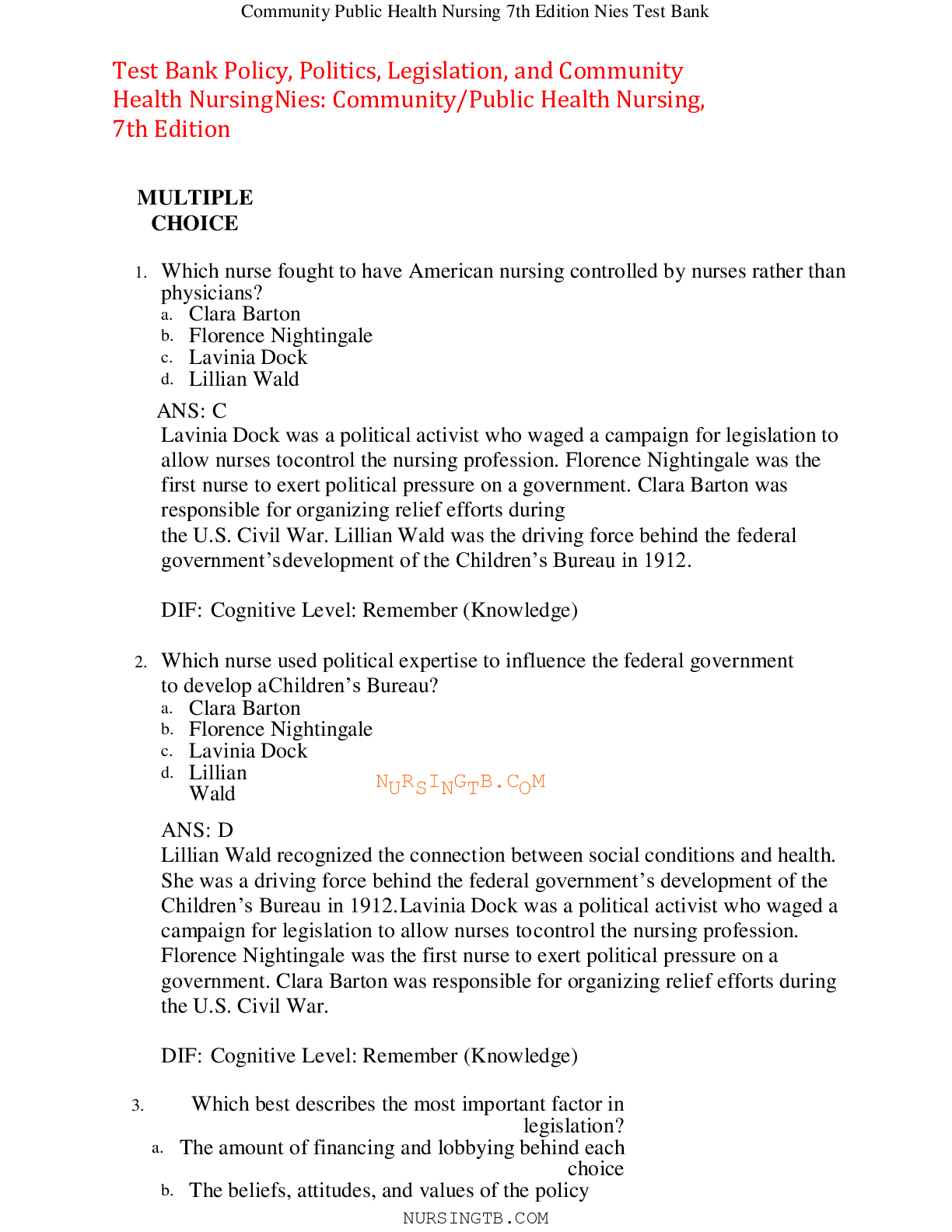
Reviews( 0 )
Document information
Connected school, study & course
About the document
Uploaded On
May 03, 2022
Number of pages
27
Written in
Additional information
This document has been written for:
Uploaded
May 03, 2022
Downloads
0
Views
43



